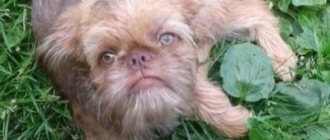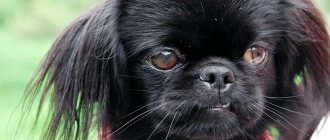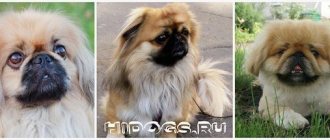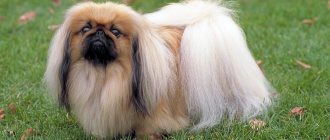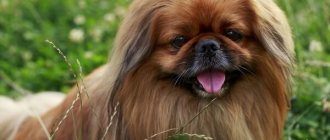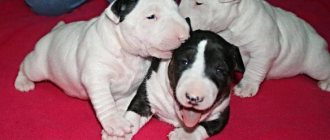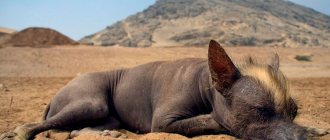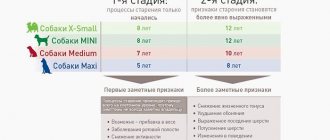One of the cutest and most attractive breeds is the Pekingese dog. Today it is considered decorative, but at one time it was bred to protect the lives of emperors. Times changed, the fashion for funny dogs with a good, friendly character either faded away or were revived again. Since the mid-70s of the 20th century, it has remained one of the most popular dogs on the market. If you need a real pet friend who is fun to spend time with, then be sure to take a closer look at the Pekingese breed. Thanks to the care of breeders, there are different species, each with its own characteristics. We'll talk about this and much more in this article.
History of the origin of the breed
The Pekingese or Fu dog, as the Chinese call it, is one of the most beautiful decorative representatives. If you translate from English, you get the word “Beijing”. Considered the pet of emperors. The theft of a puppy by commoners could result in the death penalty.
The Pekingese is similar to a sacred lion, considered a deity. The Chinese have a legend: the king of beasts fell in love with a monkey and took her as his wife. The born child inherited the mother's appearance and the father's character. The little furry favorites of the “celestials” of the imperial dynasties are guardian spirits. The breed was bred for protection.
The Chinese dog ended up in Britain after the capture of the Summer Palace in Beijing during the Opium War (1860). The European “journey” began with 5 puppies and quickly gained popularity. The first exhibition was organized in Europe, and the amateur club was organized in the USA.
The breed has a 2000-year history. Compared to the first dog, the ancient exterior has changed a lot. They are shorter, with long hair, distinguished by a proud gait and calm disposition.
Pekingese health and diseases
The most common diseases of this breed: urethritis, problems with heart valves, displacement of intervertebral discs, the formation of tumors on the perianal gland, various eye diseases.
If you regulate your Pekingese's diet, if you clean his delicate eyes well, if you brush his teeth, which are his weak point, you can keep your Pekingese for up to 15 years. It's not much compared to other dogs, but you have to take care of it. A small dog with long hair, it carries all the dust from your apartment with it, and its good health depends on its maintenance.
Pathologies and common diseases of the Pekingese
The Pekingese is a very healthy dog, and according to the 2014 Kennel Club Purebred Dog Health Study, about three-quarters of the animals studied were not affected by any disease. The main causes of death were old age and brain tumors. Like other purebred dogs, Pekingese are susceptible to developing hereditary diseases. These include congenital dislocation of the elbow, distichasis, ectopic testicles, inguinal and umbilical hernias.
Congenital dislocation of the elbow
Congenital elbow dislocation is a relatively rare condition. It is characterized by displacement of the bones of the elbow joint, ulna, and is accompanied by rupture of the ligament. Between four and six weeks of age, your dog may develop lameness and elbow deformity.
X-ray examination confirms the diagnosis. Surgical treatment should be started as soon as possible and consists of returning the joint to its natural position before temporarily immobilizing it in that position using a cast.
Distichiasis
Distichiasis is characterized by an additional row of eyelashes in the area of the meibomian glands, which secrete a protective fluid for the eyes. Depending on the amount, texture, and friction on the eye, this extra row may make no difference or may cause keratitis, conjunctivitis, or corneal ulcers.
Types of Pekingese
Dwarf
Such dogs are often called “pocket” dogs. They are outside the standards and are not submitted to exhibitions. This is a genetic abnormality. The breed does not allow for excessively small sizes.
Royal
The Pekingese of this species occurred as a result of crossing with larger representatives. Initially it was planned as a representative dog for the nobility. Height at the withers reaches 30 cm.
Chinese
The classic Pekingese is a representative of the breed with long hair, a dark muzzle color, and a protruding tongue. The color is red with tan.
Smooth-haired
Result of selective sampling. Despite the ease of grooming, they have reduced immunity, a short life expectancy and genetic deformities.
Imperial
Synonymous with Royal Pekingese. This name is a common marketing ploy for the better sale of offspring.
Appearance
Breed standards allow for a variety of colors, but the most common is red. There are also black, fawn, and colored Pekingese. But the rarest color is white. The Pekingese's muzzle often has a black mask (which is optional), the eyes are large, dark and very expressive. There may once have been a breeding line of English Blue Pekingese (that is, visually gray).
Height at the withers is approximately 15-25 cm, the preferred height of bitches is up to 23 cm; males weigh 3.2-5 kg, females 3.6-5.4 kg[1]. There are also larger specimens, weighing up to 8 or even 10 kilograms. Dwarf Pekingese, contrary to popular belief, do not exist, but a “pocket” variety can whelp, weighing no more than 2.7 kg.
The eyes are wide apart. The muzzle is short and wide, upturned, with a transverse fold on the bridge of the nose and a large lower jaw. The nose is black with wide open nostrils. The profile is snub-nosed, the nose is at eye level.
Description of the breed
Dimensions
According to the RKF, the Pekingese breed is distinguished by the fact that the female weighs 0.5 kg more than the male. There are corpulent specimens up to 8 kg. The height at the withers reaches 0.25 m. Above this value is considered a deviation from the norm. Dogs live up to 12-13 years. It is not uncommon for long-lived dogs.
In profile it looks like a slightly elongated rectangle with regular shapes.
Head
The breed is distinguished by a massive skull, flattened between the ears. The muzzle is short, very stretched in width. It is bordered by a V-shaped fold that goes around the bridge of the nose and ends on the cheeks.
Nose
Strongly flattened, slightly upturned, nostrils widened. The nose is brightly pigmented. Peculiarities of breathing are determined by the structure of the nasopharynx. Pekingese snores and snores in his sleep.
Eyes
Rolled out, rounded, large, which gives a surprised look and a “doll-like” appearance. The color of the iris is black. Individuals with light, mosaic pigments are not allowed to compete; they are considered breeding defects.
Ears
The Pekingese breed is distinguished by its high-set, heart-shaped ears, which are lowered to the line of the lower jaw. Their fur is soft and long.
Neck
Short, massive, which is clearly visible in profile. The breed provides for the development of the muscles of the cervicothoracic region.
Frame
The body is short, with a massive, pronounced chest, and a thin waist. The back is straight without angles or kinks with an elevation of the transition from the chest to the neck.
The photo shows the typical appearance of a Pekingese dog.
Limbs
Due to the specific structure of the front and rear limbs, the Pekingese moves importantly, slowly, as if rolling. The front legs are short, bony, thick. Metatarsal bones of the foot, joints slightly turned outward for stability, without roundness. The shoulders are laid back, the elbow joints are pressed to the upper costal part.
The hind limbs are lighter, set close together, and the feet point forward.
Attention! When selecting, you should pay attention to possible dysplasia, which is difficult to detect externally. We need to take x-rays.
Tail
Curved, set high above the pelvic bones with a curve towards the end, allowing it to hang to the left or right side.
Wool
Thick undercoat with a delicate structure, long, coarse topcoat constantly requires special care: washing, daily combing. During the molting period and in the warm season, trimming is recommended. The neck is shrouded in a large collar, which gives it a resemblance to the “king of all beasts”.
Color
Hair coloring varies depending on the subspecies. There are individuals with pronounced decorating hair of a more intense color. According to the breed standards, a white, liver tint is not allowed.
Pekingese breed standard
In the 60s, when they were first brought to England, they were in many ways reminiscent of Japanese Chins, but over time the external difference became very noticeable. They began to weigh much more, their paws became shorter, and other differences appeared that made it possible to distinguish this breed from many others. To many people they resemble lions in appearance. You can always distinguish the Pekingese by its specific muzzle, which gives the impression that it is somewhat flattened. The Pekingese has slightly bulging eyes that resemble beads. A small, extremely neat tongue with a slight degree of roughness.
Now you can find two varieties of the breed: “sleeve” and standard. Unlike the standard one, the second version of the breed is more miniature in size and easily fits into the owner’s bag. As adults, they gain no more than 3 kg of mass. Females of this variant of the breed are not bred, since due to such a low weight they simply will not be able to bear future offspring.
Head
The Pekingese's skull is quite heavy, with flattened ears and clearly defined. Dogs of this breed have a short muzzle, noticeably stretched in width.
Mouth
The mouth is small in size, containing two rows of small but very sharp teeth. The teeth are always hidden behind thick lips.
Nose
The Pekingese has a rather funny nose, it is very wide and seems to be flattened. The lobe is distinguished by a rich black shade with some pigments. The dog's nostrils are wide.
Eyes
They are often very convex, so they require special care and handling (the dog should not be hit on the head). They are most often dark in color. Dogs of this breed with light eyes are extremely rare and are rather exceptions.
Ears
They are characterized by a high seating position and are often shaped like a heart. The fur on the ears is pleasant to the touch, very soft.
Neck
This breed has a small but very massive neck.
Body
In terms of size, the Pekingese is a small dog. The part in front is always more massive than the back, while the waist is clearly visible.
Paws
The paws of this breed are massive and very short; this is largely an individual feature of these dogs. The nails are quite long and require careful handling, otherwise the dog can damage the blood vessels. Bones have good strength, but still require careful handling, otherwise fractures may occur. The Pekingese is a passive dog; it walks slowly and majestically.
Tail
It is characterized by a high seating position and is slightly curved at the end. The tail is fluffy and extremely pleasant to the touch. The coat is approximately the same as that on the main part of the body, so it requires careful grooming.
Wool
This breed is very popular for its fur. It is soft, thick, long and pleasant. There is a lot of fur on the body, neck and tail. This coat needs careful care, at least twice a week, otherwise tangles and other troubles will form that will negatively affect the dog’s appearance and health.
Color
Nowadays you can find Pekingese in completely different shades, except for some shades of brown. Also, it is not normal to have an albino Pekingese.
Character and behavioral characteristics
The Pekingese, which is cute in appearance, is naturally designed to protect. The dog itself will choose “its owner” in the family and will perfectly obey his commands. Common behavior is to follow household members. The companion dog loves to sit near the feet, surrounded by family. He happily meets people he already knows, jumps into his arms, and licks them.
The breed is not known for its excessive love for children. They do not tolerate loud sounds or screams, and will actively react to such behavior by growling and barking.
A pet of another species (cat, rat) is not a hindrance for the Pekingese. He enjoys making friends, joining in games and having fun fights.
The ideal owner for them is a leisurely person who is not in a hurry.
The Pekingese is for those who truly appreciate their greatness, royal behavior, and regal habits. It is necessary to understand the peculiarity of the origin of the Chinese breed.
Temperament and character
Inherited from their palace ancestors, the Pekingese inherited traits that are generally characteristic of companion dogs, pampered and unaccustomed to complex active work, like shepherds or hunters.
- Empathy. Those dogs who were able to make a person laugh at the right time, comfort them at the right time, and just lie next to them at the right time, without demanding attention, enjoyed greater success—and therefore more often and more fruitfully left offspring. Therefore, the ability to understand the owner’s mood and behave accordingly is hardwired into the breed’s subcortex. He will never fall into the hands of an irritated person, he will come to console someone who is upset and will gladly go to bed next to a sleepy one.
- Temperament. For such a small dog, he has excellent stubbornness and leadership qualities, which he shows at every opportunity. He likes that all the attention is paid to him, he likes that everything around him happens according to his rules, and that people do not become too arrogant. An irritated person, having not received what he wanted, becomes unbearable: he bites, demonstratively climbs into places where he cannot climb, steals from the table, breaks off the leash. You need to build a relationship with him from a very early age, build your authority from the first days. Otherwise, a small-town tyrant, a despot and a walking disaster will grow out of a dog that does not even reach a person’s knee.
- Amenability. Pekingese do not have a hunting or guard instinct, so they easily agree to share their territory with any small animals. Cats, birds, lizards, even rodents need not be afraid of the little lion - he, in his greatness, will allow them to live next to him and bask in the rays of his glory.
- Attachment. They cannot stand loneliness and feel bad if they remain at home without an owner for a long time. At the same time, they do not need active communication, games and running around. They need their owner to be nearby so that they can sleep at his feet or slip their hand under his arm so they can scratch him when they want.
Dogs of this breed are smart, loyal and have protective instincts. If the owner is in danger, the dog will bark and rush to defense, even if the enemy is many times larger than him and there is no chance against him.
At the same time, they are not very active, they like to walk imposingly and prefer lazily lying in the sun. They are recommended as companions for sick and old people: communication with them improves mood, increases the will to live and does not require effort.
Advantages and disadvantages
From the standard and temperament it is clear that the Pekingese has significant advantages:
- Amenability. The ability to get along with cats, small animals, rodents and lizards is very valuable for a pet.
- Smartness. Usually he understands everything very well, easily learns new tricks and commands, can dance with his owner or even melodiously howl to a musical instrument.
- Attachment. He enjoys spending time with his owner, learning commands with him, playing and obeying.
- Beauty. A decorative dog that looks like a fluffy little lion is a wonderful home decoration. Especially if you raise her well and cut her hair according to the latest fashion trends.
- Health. For a small breed, they are hardy and strong - they do not suffer from food allergies, live more than 10 years, and with proper prevention they are capable of a long, happy life.
Pekingese are good where you need a friend and a faithful companion, but not an assistant. They don't know how to guard, don't know how to carry things, don't know how to babysit children. They only know how to love, console and please - that’s what they were bred for. And often this is their biggest and most significant advantage.
But they also come with disadvantages:
- Stubbornness. The dog that lived in the emperor's palace still retains confidence in its irresistibility and high self-esteem. It will be difficult to force your pet to do something he doesn't want to do. And if you turn him against you - offend him, make him angry, make him bored - it will become almost impossible to deal with him.
- Jealousy. Devotion has a downside: to everything that claims the owner’s attention, the dog wants to show that he is the main favorite here and that no one dares take his place. Therefore, it is not recommended to take representatives of the breed into families with small children - or where children are expected soon. Only problems will come from this.
- Difficulty of care. Haircut, combing, caring for ears, eyes, teeth - all this is quite tedious even for a person who voluntarily chose this particular breed.
Low mobility is difficult to classify as a plus or minus, since it turns out differently depending on the situation. Next to an athlete and a runner, she will become an undoubted disadvantage. But next to an elderly woman with sore legs, on the contrary, she has dignity.
Education and training
It is believed that the Pekingese is almost resistant to educational measures and is poorly trained. Much depends on the individual characteristics of the pet. We must be persistent, teach the rules of behavior at home and on the street from the first days of life together.
Walking is carried out only in a collar or harness. The first walks and exits on the street are short. Gradually, the residence time is increased from 10-15 to 60 minutes. Despite the tendency to laziness, it is necessary to motivate the dog for long walks over long distances. It’s up to you to decide how long to walk.
It is necessary to teach the commands “fu”, “you can’t”, “yours”, “you can”, “come”, encouraging the completion of tasks with treats from the age of 2-3 months.
Attention! It is strictly forbidden to hit a puppy for misbehavior. You must speak in a stern voice, demonstrating dissatisfaction with your behavior.
The Pekingese can remain alone at home, but it is hard for him to cope with the long absence of his beloved owner.
The character of the Pekingese and who they are suitable for
It is not recommended to have Pekingese for people who have small children. This is not only because children under school age have poor self-control during play and can harm the pet. Do not forget that the character of the Pekingese is selfish and jealous. Therefore, the pet will definitely not like that the owner will pay more attention to the child. Because of jealousy, Pekingese may begin to take revenge on you. Of course, a dog will not attack children, but peeling wallpaper, chewing shoes or soaking your favorite carpet is quite in his style.
The character of the Pekingese is complex and independent. Therefore, he will play and contact a person only when he is in the mood. Otherwise, you should not force the animal, because the dog may snap. The imperial breed requires attention and respect for its person.
People who decide to have such a pet for the first time should not be afraid of its character. This temperament is quite easy to deal with if you pay enough attention to your pet and raise it correctly from childhood. To properly care for your pet and raise it properly, you need to learn everything about the Pekingese.
Representatives of this breed are perfect for busy people. They love to walk outside, but will never refuse to lie on the sofa, and especially on their owner’s lap. Dogs of this breed are very affectionate and attentive.
Diseases
The breed requires special attention to the eye socket area. The Pekingese is prone to allergic reactions and conjunctivitis. Weakness of the muscles of the eyeball leads to blurred vision, the formation of a cataract, clouding of the lens, and dislocation of the eye.
Elderly individuals are prone to arthritis and osteochondrosis. Genetically, they have a weak intestine, so it is imperative to monitor their stool, the functioning of the gallbladder and stomach.
Obesity and diabetes are some of the main “enemies” of dogs. Their tendency to overeat leads to malfunctions of the pancreas. Minimum sugar content and exclusion of sweets are the key to health.
Healthy! Prevention of diseases - all kinds of activity, motivation for physical activity, frequent walks. The Pekingese is lazy, but plays with pleasure.
Disease susceptibility
Due to the structural features of the skull (the so-called brachycephalicity), Pekingese have difficulty breathing and, although not often, the eye may “fall out” (in fact, the eye does not “fall out” in the literal sense of the word, but the so-called proptosis – protrusion and excessive displacement of the eyeball outward from the bony orbit). If such a problem is discovered, you should urgently contact a veterinarian, because delay can cost the animal’s sight. With timely consultation with a doctor, vision can usually be saved. To prevent eye “loss”, it is recommended to avoid holding the Pekingese by the neck (or collar), and not allowing the Pekingese to fight with other dogs or fall from a height.
Care
Given the nature of the Pekingese, it is settled closer to the sleeping place of the owners, which is due to genetic inclinations to protect the owners. You cannot settle in the hallway, in the kitchen, in the bathroom, or in a draft. Dampness and humidity will quickly lead to disease. Despite the undercoat, the breed is prone to colds.
One of the features is the need for constant care of the coat and undercoat. Due to the short legs, the surface of the abdomen, chest and paws quickly get dirty during bad weather. Therefore, after every walk you need to wash them.
Also, it is necessary to cut the wool.
From the first day of being at home, you need to accustom him to a routine and have in his arsenal a place to sleep with high-quality bedding made from natural fabrics and toys. Later, when the puppy grows up, special devices are needed to strengthen the grip of the jaws in the form of twisted ropes.
Maintenance and care
The Pekingese is considered an aristocratic dog, but in fact requires about the same care as other decorative dogs. A simple blanket, neatly laid in a corner where there are no drafts, will suffice. You should not place the dog bed near heating devices, as the Pekingese can easily overheat. In addition, you need two bowls for food and water, a collar with a leash, diapers and a special toilet with suitable filling. Toys for the development of the Pekingese should be purchased in moderation, and not in huge quantities.
They are quite passive, so long walks with this breed are not necessary. It is enough to go out with them for a walk twice a day for 30 minutes. At the same time, do not forget that this breed does not tolerate the hot season very well, so in the summer it is better to walk with them early in the morning or late in the evening so that the dog does not overheat. Severe frosts are also unsafe for a dog; it is better to insulate it or stay at home so as not to get sick.
Very often the breed has problems going to the toilet. They can shit outside of it in the most unexpected place. A Pekingese may continue to do this even if it has been toilet trained. This problem can be solved by removing objects that the dog shits on, or by blocking off the part of the apartment that the dog has made her toilet. At the same time, you should not poke your dog’s nose into its waste products; this will not force it to change its behavior, but will make it more vicious.
Hygienic points
It is important to consider that this dog has a specific coat that looks very soft and fluffy while the dog is a puppy, and changes by 4 months. For this reason, it is important to brush your dog thoroughly to prevent its hair from matting, and to moisturize it with conditioner to prevent the hairs from becoming too brittle.
This breed does not need to be cut or trimmed; simple brushing is enough for them, especially if the dog will not actively participate in exhibitions. In this case, its coat can be shortened a little so that it can more easily tolerate hot conditions.
Pekingese need to be bathed rarely unless there is a real need. Frequent bathing will not benefit the coat of this breed. If the dog gets dirty, it is better to eliminate the contamination locally using dry shampoo-powder. If you walk your dog in the rain, you should definitely wear a special overall that will protect you from the rain.
Particular attention should be paid to the ears, eyes and nasal fold of the Pekingese. It is necessary to check their condition at least once a week. If there are no strange odors there, then there is no cause for concern, and it is enough to simply remove earwax and other contaminants with a cotton swab. This should be done with great care so as not to harm the dog. If you smell a strange odor or notice that your pet is frequently shaking its head, you should immediately contact your veterinarian.
Eye diseases are the most common in the Pekingese. This is especially true for dogs that have excessively bulging eyes. To reduce the risk of disease or injury, do not pat the animal on the head, and you should also rub the eyes frequently. Phyto-lotions or a solution of boric acid will help with this perfectly. Always make sure your Pekingese doesn't have any discharge from its eyes. Their appearance is a reason to promptly contact a veterinarian.
Like the eyes, the fold on the muzzle requires special care. Tear fluid often accumulates in it, which creates an unpleasant greenhouse effect. In order to avoid this, you should carefully pull the skin several times a week and wipe it with a dry cloth that absorbs moisture well. In addition, it is recommended that this breed’s claws be filed down as they grow, this reduces the likelihood that blood vessels will be damaged.
If you often walk your dog, it is best to sew special slippers that will absorb moisture, and also use special protective creams, this will help avoid cracks and other problems with the paws.
Feeding
Meat with low fat content, turkey and chicken should be included in the dog’s main diet. Foods with bones should not be given to her as they can cause injury. The Pekingese can only occasionally be pampered with soft cartilage.
If you remove the fatty films, you can give the dog raw or boiled tripe. As a separate dish or in combination with other products. Eating fish is very healthy, so your dog should be given it twice a week. Once a week, you can give your dog a hard-boiled egg yolk. In this case, the amount of food should be calculated based on the age and weight of the dog.
Porridge can be fed to dogs of all ages. In this case, it is allowed to use oatmeal, millet and rice porridges. In many ways, the type of porridge should be determined based on the individual preferences of your pet. If you decide to feed your dog vegetables, then it is best to stew them, but occasionally you can give them raw vegetables. You can give any fruit except strawberries, kiwi and pineapple, as they contain harmful substances that can harm the dog’s health. It is definitely worth giving low-fat fermented milk products, as they have a positive effect on the dog’s health.
If your dog sits at home most of the time and gets minimal walks, then it is worth adding additional vitamins and minerals to his diet. But you shouldn’t thoughtlessly purchase them from the vet. pharmacy. It is better to buy what the vet recommends.
Feeding
For high-quality nutrition for your pet, it is necessary to create all the conditions. What is the optimal diet? Dog lovers advise enriching their diet:
- vitamins (fresh vegetables, fruits);
- proteins;
- carbohydrates and fats in minimal quantities.
There should always be a bowl of water. Puppies can be given milk for drinking, but try to switch to fermented milk products due to an allergy to lactose.
Holistic feeds that focus on natural ingredients are considered effective. Foods from the “premium” and “premium-lux” groups help in the development and growth of your pet. Optimally 2-3 feedings per day.
You can feed cheaply, but remember that such food is completely artificial. The Pekingese eats a lot, but remains hungry. Such species negatively affect the quality of wool and general well-being.
Mating, pregnancy and childbirth
To continue the purity of the pedigree, a mating partner must be chosen in another region or country. This will help avoid the spread of genetic diseases and eliminate closely related relationships.
Mating occurs during the “rut” or “hunt” in the female, 9-12 days from the start of estrus. The female bears fruits for 2.5 months. Multiple births are more common, with 3 to 6 kittens in one litter. The Pekingese breed are good mothers who do not refuse to feed their offspring, carefully look after them and take care of them.
How to choose a puppy
Choosing a future pet is a responsible process. If you plan to purchase from a nursery, then it is good to invite a professional owner with you. In any case, it is necessary:
- carefully examine the appearance, ears, eyes, fur, excluding the presence of parasites and purulent discharge;
- put the puppy in a typical exhibition position, stretching out its hind legs as far as possible, raising its head (experienced breeders teach dogs this from the first month);
- It is advisable to purchase after all vaccinations, antihistamine therapy, with a veterinary passport in hand;
- ask to see an X-ray of the hip joints to exclude the development of a congenital disease “dysplasia”, which cannot be treated and worsens gait.
The small Pekingese always has a big belly. Watch for the protrusion of the navel, it should not be visible, otherwise there will be a hernia.
Look at the behavior. The future pet should not look tired, sick, or lethargic. Choose for yourself and be sure to make friends. The breed is initially friendly, quickly gets used to it and chooses its owner.
Advice! Stand near the puppies. Whoever runs up to you first will be your favorite.
Price and where to buy a puppy
Puppies or adult dogs are divided into categories:
- breeding for show classes, from which it is planned to obtain offspring for the purposes of breeding, sale, they perform at exhibitions of various ranks, receive awards;
- without pedigree, when there was an unplanned mating, with minor developmental defects.
Each nursery plans the price for a breeding puppy. It consists of the pedigree and merits of the parents, location. The problem lies in the dishonesty of breeders if the breed becomes “fashionable”.
Don't think that selling through classifieds is a reliable method. This is how they get rid of culled offspring that do not meet the standards.
The price for a puppy without claims to a pure pedigree starts from 5-7 thousand rubles. For a show dog you will have to pay about 500 USD.
Owner reviews
Maria, 24 years old
I think that the Pekingese breed is the most beautiful. Their faces are so cute that it is impossible to resist. A truly human look captivates with its sincerity. I have a female, Daisy, she is 5 years old. I took it at the age of 5 months. We quickly got used to each other. We walk for a long time, we have our own company of the same dogs. I spend a lot of time on care, but it’s not difficult for me. I can't imagine my life without her!
Ivan Petrovich, 46 years old
I am passionate about Chinese history. One day I came across a book telling about the events of the Opium War. I liked the description of the Pekingese dog and its characteristics. I began to look closely and decided to buy a dog. His name is Tamerlan or simply Tami. He is a true friend with whom it is not scary. At the dacha he reacts better than a shepherd. The only drawback is the wool, but I regularly cut it myself with a regular clipper. An excellent dog with a good character.
Advantages and disadvantages
The breed has negative and positive aspects. The Pekingese is a dog with character. The table shows “positive” and “negative” qualities that will help with your choice.
| pros | Minuses |
|
|
Similar breeds
Among decorative companion dogs, there are those similar to Chinese dogs in appearance and character.
Pug. This breed is slightly taller than the Chinese Fu, without much hair. They are peaceful, calm, and good with children. They are omnivores, love to eat, gain weight quickly, and find it difficult to keep track of their figure.
Japanese Chin. Dogs from Japan are taller than the Pekingese. They have long limbs and shorter, flowing white fur with dark spots. Graceful, dexterous, friendly dog.
Tibetan spaniel. The breed was bred to guard monasteries. A more nimble little dog that can withstand long walks. The height at the withers is the same, but there is much less hair. Due to their activity they can withstand weather changes. Conflict-free, slightly aggressive.
Character
The ancient Chinese ancestors of the Pekingese had only one purpose - to be next to their royal owners or to bask on their laps. Today's Pekingese do not break traditions and still bask in the hands of their owners.
From the outside it seems that the dog with the lion's mane gets great pleasure from his own irresistibility and greatness. These small decorative dogs have the dignity and pride of kings and developed intelligence.
The Pekingese will not tolerate rudeness or raising his voice in his direction. Also, such a dog is very jealous and will not share the attention of its owners with other pets. The Pekingese can be a wonderful companion and friend for anyone, even if that person has no experience with dogs. Just before buying a Pekingese, keep in mind that the dog loves to bark for a long time and loudly. He also snores and sneezes frequently. You can’t expect silence in a house with such an animal.
Pekingese have the following character traits: intractability, stubbornness, possessiveness, selfishness, gluttony, laziness. Based on this, Pekingese do not have a good relationship with small children. The decorative dog behaves warily with strangers, showing its superiority with all its appearance.
Photo
Briefly about the main thing
- Bred over 2,000 years ago, the dog has undergone few selective changes. She remained just as proud and brave.
- The breed requires care and a lot of time.
- The Pekingese is a magnificent guard with a chic appearance of a “little lion cub” with a cross between a monkey and will charm lovers of the East.
- Large eyes in the form of large beads with a human look, full of sympathy, evoke tenderness and delight.
- The breed will appeal to unhurried, attentive owners who need a devoted pet with protective qualities.
Write in the comments, do you like Pekingese? Share your experience caring for this breed.
Did you like the article? Share it with your friends on social media. networks. This will help them get useful information and support our project.


